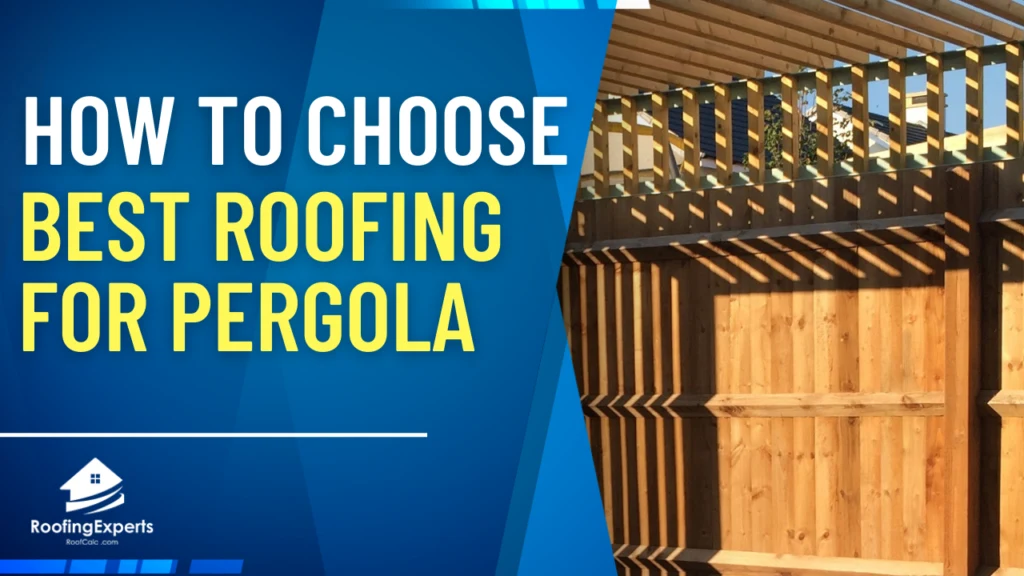
If you’re planning to build a pergola, choosing the right roofing material is critical to its success. Your choice of roofing can impact your pergola’s overall appearance, function, and durability.
In this article, we’ll provide expert tips on how to choose the best roofing for your pergola. We’ll explore different roofing options, including polycarbonate, fabric, thatch, and more. We’ll also share important factors to consider, such as climate, budget, and maintenance requirements.
So, whether you’re looking to create a cozy outdoor living space or a stunning garden feature, this guide will help you choose the perfect roofing material for your pergola. Let’s get started on building your dream pergola!
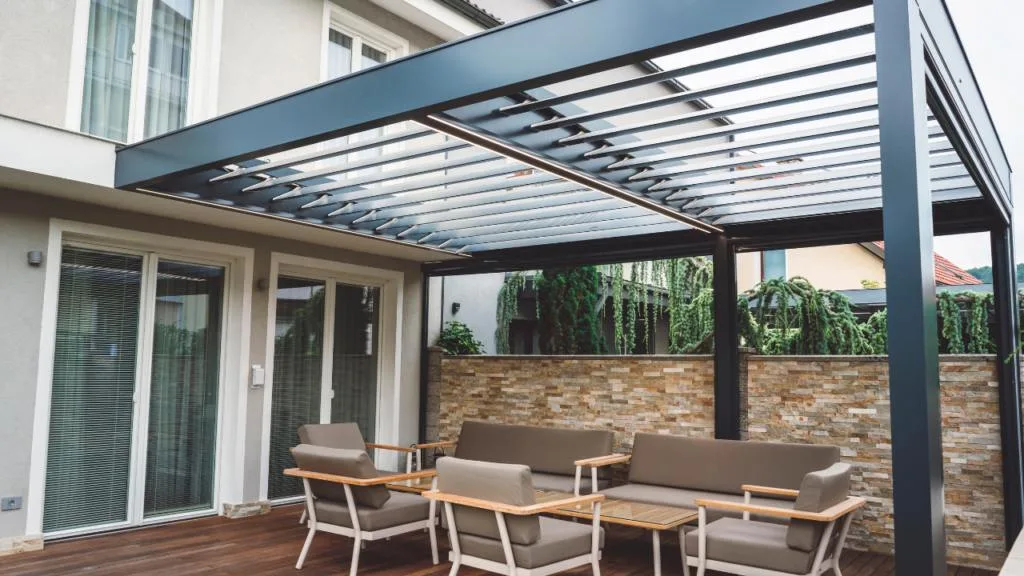
Understanding Pergolas
Purposes of Pergolas
A pergola is a versatile addition to your backyard, patio or other outdoor living spaces. They can serve several purposes, such as:
- Providing shade for a comfortable outdoor area
- Creating a focal point in your landscape
- Defining an outdoor living space or separate areas within your yard
- Displaying climbing plants and flowers on the trellis structure
- Offering a place for outdoor dining, relaxation, or entertaining
Pergola Types: Attached and Freestanding
Pergolas come in two main types, each with its own unique advantages:
- Attached Pergolas – These pergolas are connected to your home or another existing structure, like a garage or shed. They offer:
- Seamless integration with your existing architecture
- Easy accessibility from indoors to outdoors
- Increased shade and shelter near your home
- Freestanding Pergolas – These are standalone structures placed anywhere in your outdoor space. They provide:
- A separate, defined outdoor area away from your house
- Flexibility in design and placement
- The opportunity to create a gazebo-like setting with seating or dining furniture
When determining the best type of pergola for your needs, consider factors such as the size of your outdoor space, intended use, and desired location.
Additionally, you’ll want to choose the right material for your pergola, such as wood, aluminum, or vinyl, based on factors like climate, maintenance, and desired aesthetic.

Choosing Materials for Pergola Roofing
Wooden Pergola Roofs
Wood is a popular choice for pergola roofs, offering a natural look that complements many garden styles. Choose from solid wood, shingles, or reeds, depending on the desired appearance and durability.
Remember to treat the wood for increased longevity. Pros of wooden roofs include:
- Aesthetic appeal
- Affordability
- Versatility
Cons of wooden roofs are:
- Regular maintenance required
- Susceptible to rot and insects
Metal Pergola Roofs
Metal roofs, made from materials such as aluminum and steel, are another option for pergola roofing. These roofs provide durability and require little maintenance.
Pros of metal roofs include:
- Long-lasting
- Minimal maintenance
- Variety of styles and colors
Cons of metal roofs are:
- Can be noisy during rain
- May require professional installation
Vinyl Pergola Roofs
Considering a low-maintenance option? Vinyl roofing might be the choice for you.
Although less common, vinyl pergola roofs offer some benefits. Pros of vinyl roofs include:
- Low maintenance
- Water-resistant
- Resistant to rot and insects
Cons of vinyl roofs are:
- Limited styles and colors
- May become brittle over time
Fiberglass and Polycarbonate Pergola Roofs
Fiberglass and polycarbonate are lightweight, durable roofing materials often used for pergolas. Available in various colors and styles, these roofs are easy to install and can be cut to fit your pergola’s size.
Pros of fiberglass and polycarbonate roofs include:
- Lightweight
- Durable
- Variety of colors and styles
Cons of fiberglass and polycarbonate roofs are:
- May scratch or dent
- Possible discoloration over time
Louvered and Retractable Pergola Roofs
For added functionality, consider louvered or retractable pergola roofs. These options allow you to control the amount of light and shade in your outdoor space.
Pros of louvered and retractable roofs include:
- Adjustable light and shade
- Enhance usability of the pergola
- Provide privacy
Cons of louvered and retractable roofs are:
- May require professional installation
- Higher cost compared to static roofs
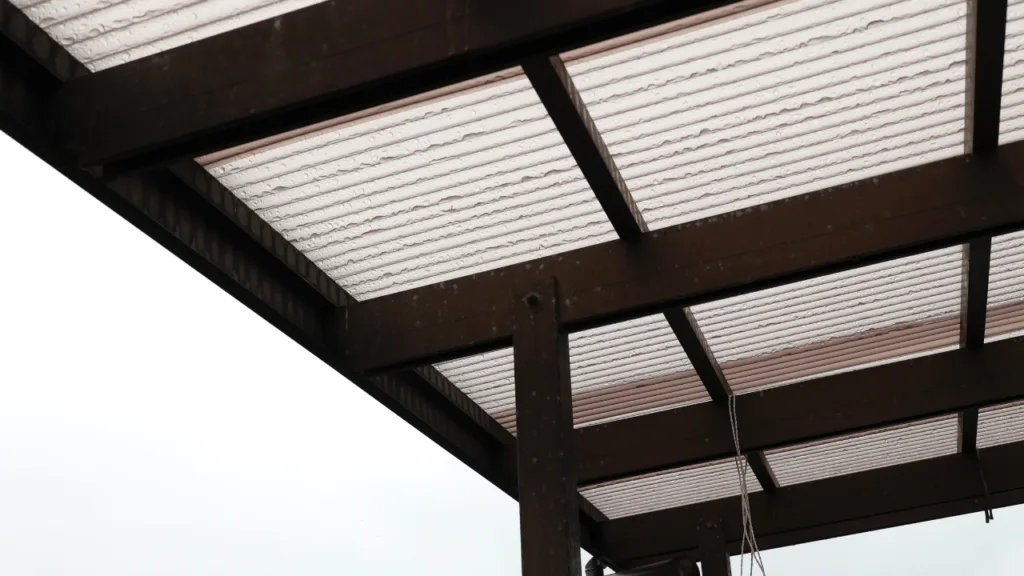
Considering Pergola Size and Style
Determining Location
When choosing the best roofing for your pergola, start by determining the location of the pergola in your yard or outdoor space. Consider whether you want the pergola to be attached to your home or to be a freestanding structure.
Both options have their own aesthetic appeal and can function differently based on your preference and space available. Take into account the surrounding landscape, the view you want from your pergola, and how it will interact with existing structures or features in your outdoor space.
Measuring Dimensions
Once you’ve chosen the location, it’s important to measure the dimensions of the pergola to ensure proper fit and style. Typically, pergola height ranges from 8 to 12 feet, with 8 feet recommended for smaller structures or those attached to your home1.
To accommodate ceiling fans and light fixtures, a 10-foot height is suitable for most pergolas. When measuring the width and length, think about how much shade and space you desire, as this will influence your choice of roofing style and materials.
Factors Influencing Pergola Design
Several factors can influence your pergola design choices, including:
- Materials: Common roofing materials for pergolas include wood, aluminum, fabric, and polycarbonate2. Each material has its own advantages in terms of durability, cost, and maintenance. For example, a 10×10-foot wood pergola may cost around $2,500, while an aluminum pergola of the same size may cost around $3,5002.
- Aesthetic Appeal: The style of your pergola should complement the overall design of your outdoor space. Consider a roof that will boost the aesthetic appeal of your pergola, such as a unique or contemporary design3.
- Maintenance: Roof maintenance is crucial to keep your pergola in top condition. Regular cleaning and inspections will help prevent damage from debris buildup or pests4. Choose a roofing material that fits your level of desired maintenance.
By considering these factors and paying attention to your pergola’s location, dimensions, and your desired aesthetic, you can make an informed decision on the best roofing material and style to create the perfect outdoor addition to your space.
Footnotes
- Tips On How To Plan A Perfect Pergola – House Digest ↩
- How To Choose The BEST Roofing For Pergola! [Do THIS!] ↩ ↩2
- Roof ideas for pergolas – including retractable designs: 11 looks for … ↩
- 5 Tips for Installing a Roof for Your Pergola – Myrooff.com ↩
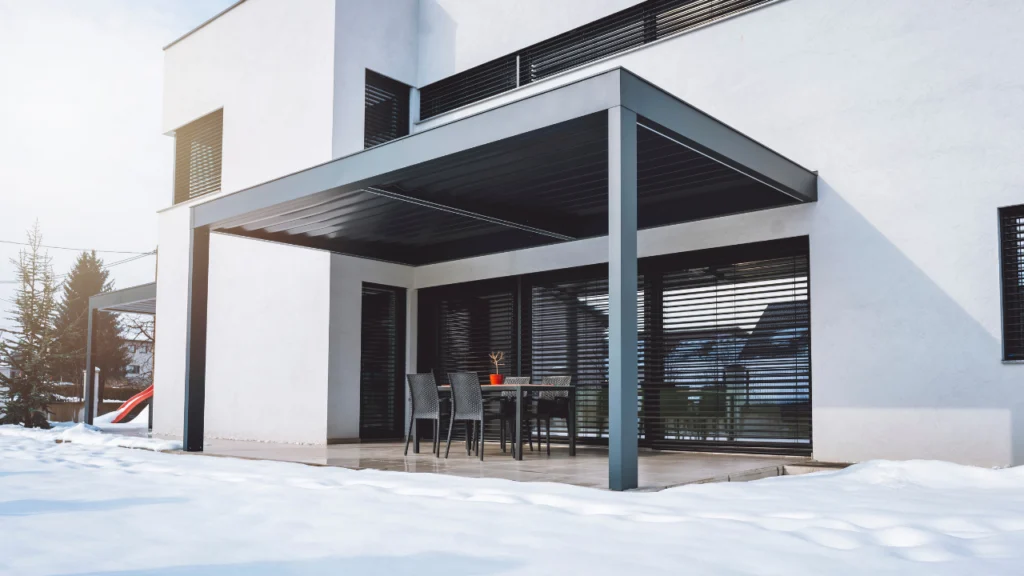
Evaluating Pergola Functionality
Shade Coverage
When choosing the best roofing for your pergola, consider the amount of shade coverage you desire. Roof options like static paneling can provide substantial shade and protection from the sun’s rays.
For more shade, choose materials like weather-resistant wood, metal, or stone with a denser lattice design, which provide better coverage and block out more sunlight.
Sunlight Control
Pergola roofs can offer different levels of sunlight control. If you want adjustable control over the sunlight entering your outdoor space, consider retractable or movable panels.
These allow you to manage the amount of sun exposure your pergola receives, providing you with flexibility and adaptability.
Wind Protection
Durable and lightweight roofing materials can better withstand strong winds. Consider the wind conditions in your area when selecting a pergola roofing option.
For added wind protection, you might choose more solid, sturdy materials like metal or stone, which can offer better resistance to the elements.
Rain and Waterproofing
To ensure long-lasting pergola roofing, consider waterproof materials that protect against rain and moisture. Some materials, like waterproof fabric or polycarbonate sheeting, provide effective rain protection while maintaining an aesthetically pleasing appearance.
When selecting your roofing option, ensure that it properly channels water away from the structure to avoid damage or rot.
| Material | Waterproof | Rain Protection |
|---|---|---|
| Wood | Varies | Moderate |
| Metal | Yes | High |
| Stone | Varies | High |
| Fabric | Yes | Moderate |
| Polycarbonate | Yes | High |
Privacy Options
Pergola roofs can also offer privacy to your outdoor space. If this is a priority for you, opt for a more solid design like static paneling or closely-spaced wooden slats, which can provide better privacy than open lattice designs.
You can further enhance your pergola’s privacy by including side panels or curtains, adding versatility to your outdoor experience.
In summary, when evaluating pergola functionality:
- Assess shade coverage needs and consider denser roofing materials.
- Choose adjustable or movable panels for sunlight control.
- Opt for durable and lightweight materials for wind protection.
- Ensure your roofing choice is waterproof and effectively channels water away from the structure.
- Consider solid designs or additional features like side panels or curtains for enhanced privacy.
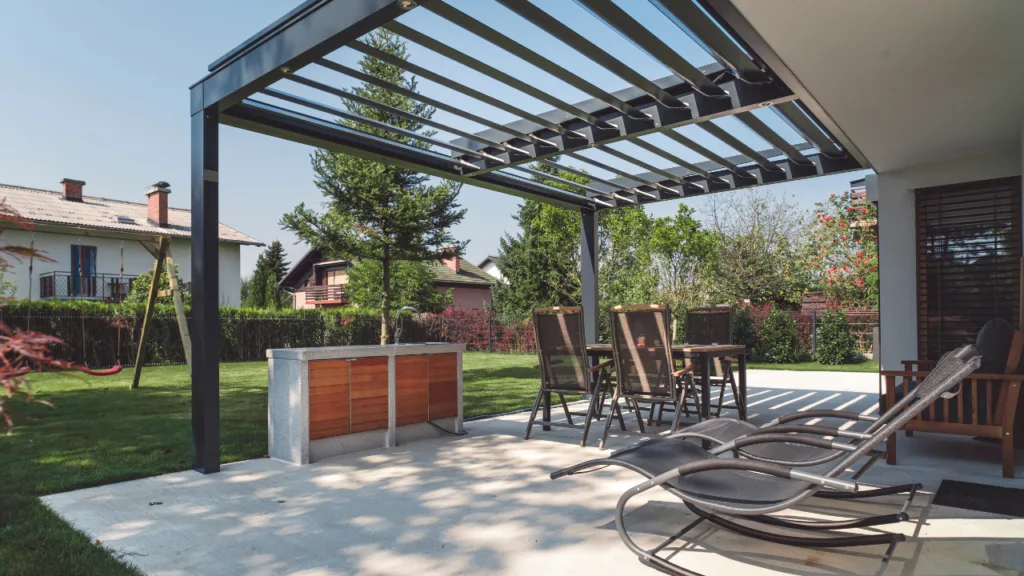
Assessing Budget and Installation Options
Pergola Kits Vs. Custom Pergolas
When choosing the best roofing for your pergola, first consider whether you want a pergola kit or a custom pergola. Pergola kits are generally more budget-friendly, as they come with pre-cut materials, instructions, and necessary hardware. You can choose from a variety of materials, such as cedar or aluminum.
Custom pergolas, on the other hand, provide more flexibility in design but may be more expensive due to labor and material costs. You’ll need to work with a contractor to determine the best materials, size, and roofing options for your specific needs.
DIY Pergola Construction Vs. Hiring Professionals
Decide whether you want to build the pergola yourself or hire a contractor. DIY construction can save you money on labor costs, but it requires time, effort, and some construction knowledge.
If you’re confident in your DIY abilities, consider investing in a pergola kit that includes all necessary materials and instructions.
Hiring professionals may be more expensive, but it ensures proper installation and can save you time. When budgeting, factor in labor costs, as well as materials and permits. Obtain quotes from multiple contractors to find the best deal for your project.
Obtaining Permits
Before beginning construction, check with your local building department to determine if you need a permit for your pergola. Permit requirements vary depending on factors like size, location, and roofing materials.
Ensure you have the proper permits in place to avoid legal issues, fines, or potential removal of your pergola.
When planning your pergola project, keep the following entities in mind:
- Budget: Factor in costs for materials, labor, permits, and any additional features, such as a louvered or automatic system.
- Pergola roof: Choose the best roofing material for your needs, taking factors like weather protection, privacy, and appearance into consideration.
- Contractors: Obtain quotes and compare their experience, quality of work, and pricing.
- Permits: Visit your local building department to determine permit requirements and submit the necessary paperwork.
By considering each of these aspects in your planning process, you’ll be more likely to make the best roofing choice for your pergola and stay within your budget.
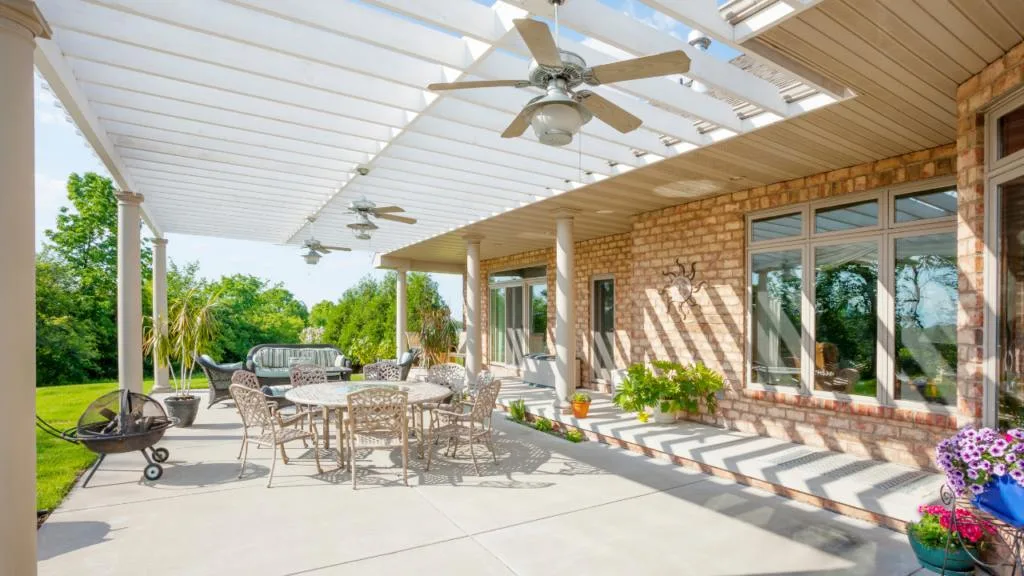
Enhancing Your Pergola Experience
Incorporating Lighting and Furniture
To create a comfortable and inviting atmosphere in your pergola, consider adding appropriate lighting and furniture. LED string lights, lanterns, or solar-powered fixtures can enhance the ambiance of your outdoor space.
When selecting outdoor seating, look for weather-resistant options such as metal or synthetic materials. Arrange seating around a focal point, like a fire pit or a coffee table, to encourage conversation and relaxation.
Integrating Plants and Vines
Incorporating plants and vines into your pergola design can transform the space into a lush, natural oasis. Climbing plants like vines and climbing roses can be trained to grow on the beams, posts, and rafters, offering a fresh and fragrant ambiance.
Adding potted plants around the perimeter creates a sense of enclosure and coziness. Ensure that your landscaping choices are compatible with your local climate and adapt to the sunlight conditions within the pergola area.
| Climbing Plants | Sunlight Requirements |
|---|---|
| Wisteria | Full sun |
| Ivy | Partial to full shade |
| Clematis | Partial to full sun |
| Honeysuckle | Full sun |
Maintaining and Beautifying Your Pergola
Proper maintenance and beautification are essential for prolonging the life of your pergola and keeping it looking its best. Inspect the hardware and structure regularly for signs of wear, and promptly address any issues.
- Staining or Painting: Apply a protective finish to the wooden components of your pergola, such as staining or painting, keeping weather and UV exposure in mind. This also allows you to customize the pergola’s appearance to match your outdoor design aesthetic.
- Cleaning: Keep the pergola clean by sweeping away debris, such as leaves or branches, which could accumulate on the panels or rafters. Additionally, polish any metal hardware, and clean the furniture and lighting fixtures as needed.
By paying attention to these key elements – lighting, furniture, plants, and maintenance – you can create an outdoor oasis that serves as an extension of your living space, where you can enjoy both relaxation and entertainment.
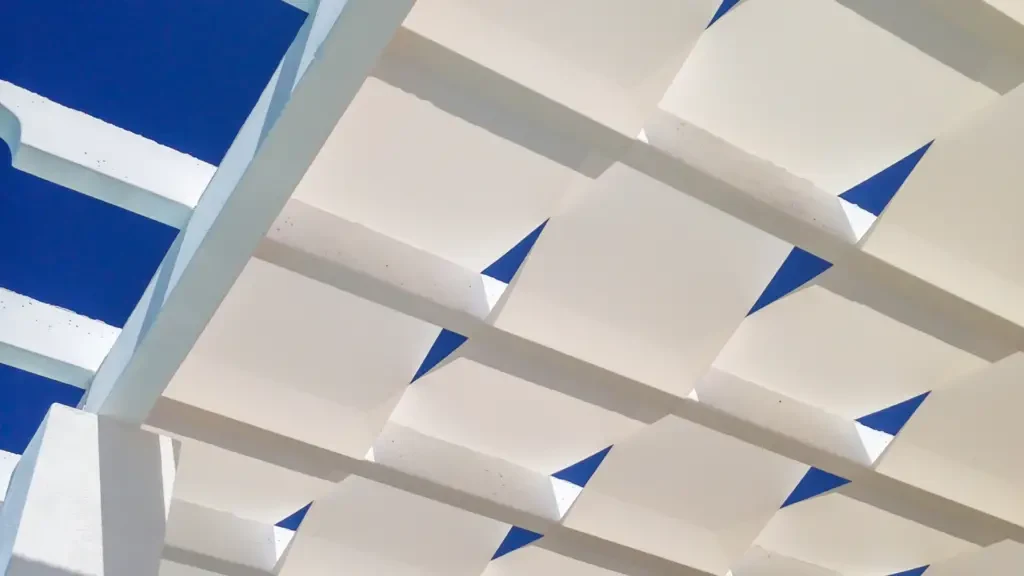
Conclusion
In choosing the best roofing for your pergola, consider the climate in your area. Opt for a roof material that can withstand the specific weather conditions, such as heat reflecting or rain protection.
Materials like wood, aluminum, and steel offer different advantages. A wooden roof, when treated, is durable and provides a variety of aesthetically pleasing options.
Aluminum is lightweight and rust-resistant, while steel holds up against strong winds and heavy rain but requires more maintenance, like preventing rusting.
When selecting the design, consider options like adjustable or retractable roofs for better control of sunlight and shade throughout the day.
Ultimately, choosing the right pergola roof will help enhance your outdoor living space, providing comfort and protection, ensuring your pergola is tailored to your needs and preferences.

